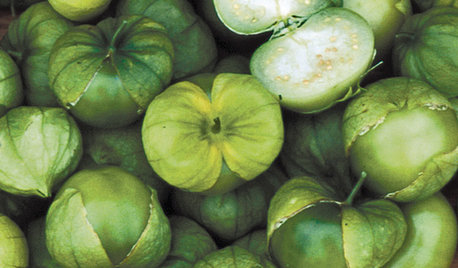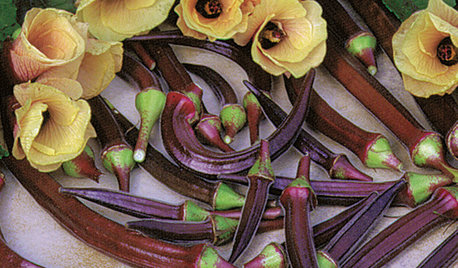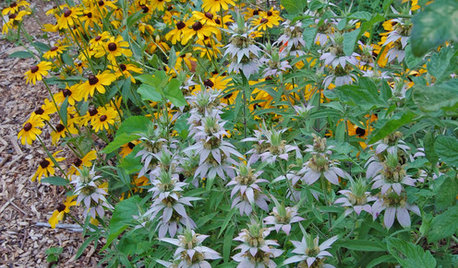Unusual Vegetables
One of the joys of gardening is being able to grow something "off the beaten path". It could be an exotic species, or just a very unusual heirloom variety of a popular vegetable.
For example, I grew several unusual members of the gourd family this year (Mexican Sour Gherkin, West India Gherkin, and Bitter Melon) and two unusual tomatoes (Red House Free Standing [needs no support] and Elfin [almost leafless, with hundreds of fruit]).
What is the most unusual "edible" in your garden this year?
Comments (124)
asa_s
17 years agolast modified: 9 years agoI grow malabarspinach in large (20-25 liter) black pots on my porch, it grows very fast during the summer several meters we have had very warm and sunny summers in the last years (and this year we have had no winter so far, no snow, and temperatures above freezing). I make a lot of quiche with malabar spinach during the summer, I like the taste of malabarspinach.
floridian
17 years agolast modified: 9 years agoHi Skirret
Malanga is a tropical root vegetable, used similar to potatoes, i.e. you can make fritters with it, roast it etc. My neighbors are from Haiti and I tasted Malanga fritters for the first time this Christmas at their party and they were very tasty. Since I live in a subtropical climate potatoes don't really grow very well down here in South Florida, so I decided to give Malanga a try - I simply bought a root at the local grocery store and planted it. Let's see what happens... The botanical name is Xanthosoma ssp. Here's a link for more info:
http://edis.ifas.ufl.edu/MV090
Cheers
AnnetteRelated Professionals
Wakefield Landscape Contractors · Concord Landscape Contractors · Fort Payne Landscape Contractors · Kailua Landscape Contractors · Kettering Landscape Contractors · Lantana Landscape Contractors · Lehigh Acres Landscape Contractors · Miller Place Landscape Contractors · Pleasant Hill Landscape Contractors · Tewksbury Landscape Contractors · Wallingford Landscape Contractors · Wareham Landscape Contractors · North Aurora Landscape Contractors · Shenandoah Landscape Contractors · Elk Grove Village Driveway Installation & Maintenanceskirret
17 years agolast modified: 9 years agoTo floridian -thanks for this information.I know them as yams and they are not available here so far as i know.But as with many other veges they appear in the shops from time to time and I keep a constant lookout to grab some to plant!
To asas s - malabar spinach is also known as running spinach and in my garden it ran from one end of the vegetable garden to the other in the space of 9 weeks.......I call it Day of the Trifids.I like the taste too but now grow it in a pot incase it strangles me in my bed.....
To zeedman - have sent you an email on your home page, no worries, would love to correspond.Let me know if you have not received the email.Diggers Club I have looked into but they have a limited number of heirlooms and are expensive to join.I have however got brochures on all the other seed companies here and have sourced everything I can through these.
The Eastern States allow many more plants and seeds than Western Australia.It is very difficult to send seed to WA and vice versa.I hear talk they are looking at letting NO more new plants in of any kind.Which is hard because the reason I searched for a site like Garden Web was because I could not find enough people with similar interests or the breadth of interest,experience in gardening locally,to converse to and swap seeds with.There simply isn't the population here to warrant it and gardening as a popular pastime has only really taken off since the 90's.My kind of "grow-it -all- yourself-and-eat-anything" attitude is uncommon here.The blocks now being sold are so small you could not find the room anyway!I also use transplants to extend the season or just because this is sometimes more reliable.My greenhouse is 3 sided though.10 years ago the winter temperatures were colder and I recall fitting polestyrene sheets around the greenhouse(which then had four sides!),to keep things warm.I also used polestyrene boxes that supermarkets packed broccholi in.Into these I placed bubbles of polestyrene,then buried a tin in it.I filled the tin with hot water and placed my seedlings around it in the box with the lid on.The heat permeates out and is a cheap source of heat.This kept them warm at 0 centigrade overnight.You have to remember to take the lid off the box each morning though.
A few cultivars from east Germany have arrived here too.
I have elephant garlic.Is that grown in the US?It is very large and pink.
Today in the supermarket I came across an onion of a pink and white colour.Looks like a swirl of icecream, kind of alternate stripes of colour.The supermarket is often my garden centre so i grabbed some and will see how this grows.
On the subject of unusual vegetables, I have a large white chinese sweet potato.It is not available in the shops or in any catalogue or garden centre and was brought here by the chinse population working in the gold mining areas over a century ago.I was told it was rare,at least in WA.I have no idea what it is called but am happily maintaining it and it is taking over my front garden, working its way to my lillypilly tree just as happily!zeedman Zone 5 Wisconsin
Original Author17 years agolast modified: 9 years agoSkirret, does your Chinese white sweet potato have deeply-cut leaves, and narrow twisting tubers? I grow a Philippine sweet potato that has white tubers, but it is primarily grown for its tasty shoots & leaves. (Reminds me of a joke I heard about a panda...) It is prepared in a similar fashion to water spinach, to which it is related.
Elephant garlic (which is really a bulbing leek) is indeed grown in the U.S. It is available in supermarkets, but is fairly expensive. I have been multiplying some stock for several years - it does not multiply rapidly - and hope to begin large-scale harvest in the coming year. It overwinters here (with mulch as protection) even down to -28C.
Can you presently exchange seeds with the other countries? Any problems?
skirret
17 years agolast modified: 9 years agoHi zeedman
Conditions for importing to Australia (just been looking this up)and include exert:"The guidelines are basically set out as follows:
- Check the "Import Conditions Database" section to see if the product you want to import is allowed and the conditions that apply to it.
- Check with your State/Territory Agricultural Department for any special requirements
- Lodge an Import Permit (often a small fee applies) for a species that hasn't previously been imported into Australia. Species already imported into Australia will not require one. You may need an import permit before you import any nursery stock.
- Then, when products arrive they will be inspected and classified according to risk.
If you buy imported seeds that are confiscated, AQIS will send you:
a covering letter;
an action notice;
a risk assessment form;
an AQIS "New Plant Introduction Form".
There are a few ways this matter can be dealt with:
1. Do nothing and the seeds will be destroyed after 30 days
2.Fill in the "New Plant Introduction Form "and return it to AQIS for assessment
3. Send $42.00 Aus. to have the seeds returned to the sender, or, to be treated and held in Quarantine for 30 days.
A warning is also given about the fines that may be incurred for illegal importations and a note to notify the exporter of the risks of sending these seed to Australia."
No, my sweet potato has very ordinary sweet potato leaves like the others.
It is 4.21 in the afternoon here,my beans are frying and it is 41C in the shade, so if you have snow send some quickly!!!!oldgaredneck
17 years agolast modified: 9 years agoFound some unusual tomatos when I went to the ville today
dawei39
16 years agolast modified: 9 years agoI am looking for info on a bean that was sent to me from NYC by a friend who is from Puerto Rico - I am told this is a "pole bean" - The pod, which I have see when dried - was at least 1 foot long and about 3/4 of an inch wide - the individual beans are at least an inch in length and are brick red in color -
I planted the three that I was given and they have begun to grow. Now someone else from Puerto Rico tells me they cannot be eaten - if I get a ton of these giant beans, I would like to know if they are edible or not because otherwise what would I do with them?
I know they are climbing beans because I planted one in the winter inside and it ran all the way to the top of the kitchen window before it finally died from a lack of good light. These are outside and I want to know if they are more than just a conversation piecedecolady01
16 years agolast modified: 9 years agoI'm growing three things that are new/unusual to me:
adzipary squash, from Turkey
yacon, aka Bolivan sunroot
yellow flowered climbing bean - these beans are very large, too, and I need to find out if they are edible.I love trying out new and unusual vegetables.
Becky
Violet_Z6
16 years agolast modified: 9 years agoJim,
A Chinese friend told me that there are two types of water spinach (ong choy, isn't it?). One type is actually grown in water, the other grows in regular soil. I assume my friend is correct. Can you who grow it verify?
Yes. This is correct.
I plan to buy some fresh ong choy and plant it. Apparently it roots easily.
It does. It's sometimes sold as an aquatic plant at pond stores. In some states like Florida, it is considered an invasive weed. A shame because it is absolutely delicious!
dawei39,
Are the beans green and then dry to the other color as many beans do?
marial1214
16 years agolast modified: 9 years agoI tried mesclun greens this year, that was unusual for me. It contained an assortment of: mustard greens, watercres, mache, arrugola, tat soi (spoon cabbage) and a big purple leaf plant that I havent yet been able to identify.
Much different than that crap in the bags in the grocery store. Much better, stronger in taste too but I like that. I just put on more mustard vinigarette to cut the strongness of the leafs. Tasty.
aka_peggy
16 years agolast modified: 9 years agoMarial, look at the link to see if you see the "big purple leaf plant" in your mesclun mix.
Dawei, you'd have better luck getting an answer to your question if you started a new thread. A picture would also help.
marial1214
16 years agolast modified: 9 years agoOH dear. the big purple elephant leafs are Giant Red Mustard. So beautiful and ornamental to grow. The plants have all flowered already and gotten so big I'm afraid to eat them anymore cuz of the flavor possibly not being as good as when they were young and tender.
Thank you kind lady aka Peggy.
iacche
16 years agolast modified: 9 years agoI'm growing a couple uncommon dry pole beans, Amish Knuttle and Aunt Jean's.
I'm also experimenting with some summer squash varieties that are new to me, but hardly unusual (Lebanese White Bush and Costata Romanesca).
My most unusual veggie is gigantes. It's a Greek dry bean similar to a lima bean, grown as a pole bean. The name means "giants" (they're big). I fell in love with them when living in Greece. I first grew them about 10 years ago from a package of gigantes bought in a Greek market. I've been saving my seeds and have grown them a few times since then.
zeedman Zone 5 Wisconsin
Original Author16 years agolast modified: 9 years agoOnly a few new oddities this year:
{{gwi:113973}}
Pea, "Purple Pod Parsley"
Where most peas have tendrils, this one has parsley-like leaves... and purple pods. Haven't tasted it yet, it's supposed to be a table pea.{{gwi:24969}}
New Zealand Spinach (close-up follows)
{{gwi:113974}}More to follow, as the season progresses.
atash
16 years agolast modified: 9 years agoI grow Miner's Lettuce--Claytonia perfoliata--as a winter crop and Purslane as a summer crop.
Neither one turns bitter when they bloom, although domesticated purslane seems to want to seed from every single shoot and I don't seem to get any good long runs of leaves.
I have a horrible time with plain old lettuce. It always seems to be too hot or too cold for it to germinate, and then it grows really slowly (getting smothered by every other green in my salad beds) and promptly bolts on me. I'm going to try it as a Fall/Winter crop this year, having bought some extra-hardy lettuces.
I don't consider Rocket aka Arugula to be an unusual crop; it's easy to grow and common in salads here. It is one of the easiest salad greens to grow. I also don't consider Corn Salad aka Mache to be unusual, tho probably many people don't know it. Rocket is a weedy-looking mustard family green with potentially a strong mustard-sesame flavor. Corn Salad makes cute rosettes and has a distinctly nutty or perhaps even "meaty" flavor. Rocket is about as hardy as lettuce and tolerates mild short frosts but nothing too hard. Corn salad is rather hardy and always overwinters here without a problem.
I tried Salad Burnett as a perennial salad green. It is tough and flavorless all year round, as far as I can tell. Nobody in my house will eat it except me (and I'm stoic). Too bad. I wish there were some convincing perennial salad greens. It's gonna get yanked. It's weedy too.
Several of you are growing Cardoons--essentially just wild Artichokes but coldhardier and more vigorous than their domesticated counterparts. I'm growing Artichokes. I thought they would give me two crops but they only gave me one! Stopped growing in warm weather. Maybe when cooler weather arrives they'll try again.
I too grew hull-less pumpkins. Also neck pumpkins, but I think the neck pumpkin seed was mixed in with some striped cushaw because that's what my one and only fertile fruit looks like. Should have been tan without stripes. Neck pumpkins are the sweetest (what commercial pumpkin pie is made of--not the round ones which are bland), and they keep a long time.
Hull-less pumpkins are a strategic crop, if you ever wanted to live off your produce. The seeds (they are grown for the seeds) are rich in protein and oils. Unlike sunflowers, they don't need to be hulled because they don't have any hulls.
"Garlic Chives" is a Chinese vegetable harvested for tender young leaves, which are stir-fried, often with eggs. It has a rather mild flavor for its family.
Another interesting vegetable was "Mien dou", peavine. A Chinese variety of pea grown for the tender young shoots. Tastes a bit like spinach, but I would say better. Mine never gave me that many shoots, tho, before bolting to bloom and turning tough. So, at that point, I harvested the young pods! Maybe it would work better as a fall crop, since the cooling weather would discourage it from blooming.
Last year I grew chick peas aka garbanzo beans. Highly recommended!!! I am at 47.5 degrees latitude, and any bean that bears here must be an easy one. I dunno if it makes any difference, but they were the variety "Kabuli black". I think they will make weirdly colored (ashen grey?) hummus. They are produced on neat, short plants that don't need any staking. Really didn't seem fussy about the weather. I got a good crop. And they fix nitrogen too.
Some more recommended crops include afolia type yellow soup peas, which are really easy to grow (I grew them from a bag of Ikea yellow soup peas) because you don't have to trellis them, and "Blue Podded Soup Peas", which don't really have blue pods (more like purplish-brown), but the pods are really easy to spot because of their color, AND the peavines have GORGEOUS big rosy-red blossoms. The blue podded peas grow on huge vigorous vines and unfortunately do need to be trellised.
My really unusual crop this year is Quinoa. It was supposed to be a dwarf ornamental mixture. I am happy to say that I did get a few good colors, including deep rose, orange, and yellow. It was NOT dwarf, but typically 4-6 feet tall, and more on the taller end of the range for that matter (they were supposed to be around 2 feet). Now the problem is that I have no idea how or when to harvest it. That's going to be my next post!
Other than the pretty seed heads, Quinoa is one ugly crop. Looks like a weed. My wife complained.
aka_peggy
16 years agolast modified: 9 years agoI'm growing asparagus pea this yr but haven't eaten any yet. Maybe in a week or so I'll get to try them.
Technically, 'Lotus tetragonolobus' they're neither a pea nor are they in the asparagus family.
I had a difficult time germinating the seeds but I did get a few plants.
Also tried growing salsify. No luck. I'll try it again next yr tho.
shilohyn
16 years agolast modified: 9 years agoHas anyone tried these? They both sound interesting but I don't know if they would grow around Chicago (z5).
Gourdseed corn
Oka melondigit
16 years agolast modified: 9 years agoAnd, we never found out about your success with over-wintering Nebuka bunching onions, Zeedman.
Steve
lilacs_of_may
16 years agolast modified: 9 years agoI've grown (or tried to grow) some veggies that you can't get at the local Safeway, such as blue potatoes, round zucchini, white/red/purple carrots, purple broccoli. I also grow garlic other than the ordinary store garlic. Never did get anything from the broccoli and the zucchini, though, but the blue potatoes were tasty.
deanriowa
16 years agolast modified: 9 years agoI am planning on growing these not so common vegetables next year:
Melon Pear/Pepino Melon(Solanum muricatum)
Achocha(Cyclanthera pedata)
Adapazari Squash
Mexican mouse melon/Mexican Sour Gherkin(Melothria scabra)Anyone have experience with any of these?
aka_peggy,How did your asparagus pea turn out?
Dean
zeedman Zone 5 Wisconsin
Original Author16 years agolast modified: 9 years agoDigit, funny that you ask... I was just thinking of posting about the bunching onions.
8 of the 9 bunching onions trialed were started as seedlings in 2006, and all over-wintered with varying degrees of success. The last, "Get Set Red", was sent to me as plants in the Spring (all of which died).
"Evergreen", "Fuyuyo", "Red Beard", "Shimonita", and "Welsh" had larger stalks, up to 1" in diameter - some "Welsh" even larger, although their size varied considerably. They had little to no dividing the first year, and as a rule, suffered more winter-kill than the multipliers. "Fuyuyo" was the hardest hit, with over 50% lost; "Evergreen" was the hardiest. "Red Beard" didn't live up to its name, with only faint red coloration. I believe these varieties are best grown as annuals.
{{gwi:113977}}
"Welsh" bunching onions (quarter in photo for size comparison)"Four Seasons", "Franz", and "Stevenson" were multipliers. They proved to be exceptionally hardy, with no noticeable winter-kill. "Four Seasons" had stalks 15" high, about the size of supermarket scallions... and was an _incredible_ multiplier, forming clumps 4" across in its second year! Think of an onion that multiplies like chives.
The other two multipliers ("Franz" & "Stevenson") were larger, 24" high & stems 1/2" to 3/4" across. They were less prolific than "Four Seasons", only dividing into 5-6 stems after the first year... but extremely large & vigorous. They were the best compromise of size, quality, multiplying, and hardiness. They were so tough, in fact, that they survived several attempts to till them under... so I have given them a permanent place in the garden.
{{gwi:113979}}
"Franz" & "Stevenson" bunching onions (block in front)Dean, when I lived in SoCal, I considered growing Pepino. It is a perennial shrub that requires a long frost-free growing season, such as they had in San Diego. Chances of success for our area are small; but if you decide to try it, do so in large pots that can be brought indoors.
I grow Melothria scabra (now sold as Mexican sour gherkin) each year; they are pictured in a group photo earlier in this thread. It is a heavily-branched but dainty climbing vine, growing 4-5 feet high on a trellis (think the same trellis you would use for tall peas). At first glance, it appears to be very much like ivy. Once flowering begins, the vines set a single 1" fruit at each new leaf node; they are best picked smaller than that. For best results in our area, it should be started indoors in peat strips 2-3 weeks before it will be planted. The seeds are very small, I usually plant 5-6 per pot & thin to 3. Unlike most cucurbits, they can be started under artificial lights without the seedlings immediately becoming leggy. Plant the clusters 2 feet apart in the row.
I grew asparagus pea last year. It is a close relative of the winged bean. The small, spreading plants had very attractive red flowers. However, the tiny four-sided 1" pods were tasteless, developed fiber very quickly, and were few in number. Interesting, but IMO, not worth growing as a vegetable. It seems to prefer cooler weather, coming on strong in the Fall; so it might perform better where favas are grown successfully.
digit
16 years agolast modified: 9 years agoBeautiful onions & photo's Zeedman,
I've found Four Seasons at Evergreen Seed Company but not the other 2 multipliers.
Agrohaitai and Kitazawa both carry bunching onion seed.
Are you ready to give the guy in the link a run for his money?
Steve' digits
jwr6404
16 years agolast modified: 9 years agoThis year I grew some Greek Zucchinni,Armenian cucumber and Adapazari Squash,all from seeds I got from Turkey. I tried growing the Hmong Red Cucumber but the seeds failed to germinate,probably my fault. Will try again next year. This Cucumber looks like the normal cucumber but turns Red,inside and out,when ripe.Seeds are available from Hirts Seeds.My big effort next year is the Uminami Cucumber. It's been a long wait but I finally expect the seeds this year. This Cucumber needs to be grown on a trellis as it is huge. Cucumbers get 24-36 inches in length and 3-4 inches in Diameter. They are supposed to be sweet. Hopefully we'll see next year
aka_peggy
16 years agolast modified: 9 years agoI never got to eat the asparagus peas, the resident rabbit ate them. I went out one day and they were gone, nothing left, nada! The darned rabbit was small enough to fit through the rungs in my garden gate.
As zeedman says, they are beautiful plants and I've read that you should harvest them very young as they do get tough. I guess I won't try them again...especially since I used up all my seeds and would have to order more.
lilydude
16 years agolast modified: 9 years agoI found a source for skirret, sea kale, and a lot of other strange veggies. See the link below. I just sent in an order. You need to be VERY patient when using their online order form. You can't back up in the process; the form will go blank. I don't recommend the online form for people with short tempers (like myself).
zeedman Zone 5 Wisconsin
Original Author16 years agolast modified: 9 years agoRe-reading this thread, I realize that I missed replying to something.
Jim (JWR6404), you have a real knack for uncovering the unusual. The Uminami cucumber sounds interesting. What was your source? I trial one Asian cucumber each year, and it sounds like a good prospect.
larry33843
16 years agolast modified: 9 years agoAlways fun to try unusual vegetables & fruit.
I have just harvested our first Carribean ackee (have one tree 10' tall, several smaller)and pigeon peas which are over 8' tall. I got my seeds from a Jamaican friend.
I have a breadfruit tree about 4 foot high which I planted in August of this year. it has grown almost a foot and put on eight new leaves. It is going to be quite a challenge to keep alive this far north. it's reported to slow growth @ 60*F and to die @ 40*F. As I write this, it's under a PVC frame covered in canvas with an automatic Vornado space heater set on 75*F. This is the 3rd nite I've used the heater this winter. Gonna be a long winter keeping that breadfruit tree alive.lilydude
16 years agolast modified: 9 years agoI just tried Radicchio for the first time today, and I love it. It's got the strong flavor of endive, but it's not leafy; it's crisp and crunchy like raw cabbage. Wonderful stuff! I just chopped it up and tossed it with some olive oil, wine vinegar, salt, sugar, garlic powder and pepper.
chaman
16 years agolast modified: 9 years agoNow that I am successful in growing Moringa Oleifera and Chinese Wolfberry I thought it will be a good idea to post the pics. on the thread.
Moringa Oleifera
Chinese Wolfberry
Scott Schluter
16 years agolast modified: 9 years agoThis thread is riveting, thanks guys.
I had a horrible time with vine borers this season so I'd like to replace my summer squash, pattypan squash, zucchini squash, and pumpkins with varieties that won't have the borer problem. I do lasagna gardening since the rest of my property is sand, sand, sand. If I am reading correct, the following would be good substitutes for our squash? (I'm in Zone 6B/7, southern New England)Costata Romanesca
Lebanese White Bush Marrow
Zucchetta Rampicante TromboncinoWe'd love to grow a cousa, but can't determine if they would be susceptible to the borers. Also a pattypan type would be great.
I think we will try the following from the great stuff posted here:
Wolfberry
Malabar spinach
Ground Cherry
Yellow Lemon Cucumbers
Strawberry SticksComments/suggestions? I'm pretty new at having a space to garden (new house 1 growing season under my belt) but I've always had a green thumb, nursing plants back from the dead out of the dumpsters, so I'll try anything. We had a pretty successful season last year in our lasagna beds and I plan on expanding that effort. Got a bunch of drying beans (pinto, kidney, cranberry) but decided they weren't worth the effort for the cost of dried in the store.
What we plan to grow:
Got heirloom tomato seeds saved (tons last year)
Green beans
Wax beans
Kale (mmmm kale soup)
Mesclun or various lettuce
Carrots (have never had luck, trying Chantenay Red Core)
German Chamomile (great tea)
Rhubarb (does great here)
Pumpkins (trying Marina di Chioggia)
Winter squash (trying Sweet Meat, Cushaw)
Summer and zuccini squashes mentioned above plus Round-8 Ball)Sounds like a lot, will probably grow small quantities of each and save the seeds for the next year as I expand my beds this season. We're also creative planting in non traditional locations (along the walkways, in the edge of the woods, planters, and pots/pans) Comments? Suggestions?
Thanks in advance.
fliptx
16 years agolast modified: 9 years agoI'm growing Spigariello, aka "Leaf Broccoli." (I posted a picture of it here. It's got lovely, dark blue-green leaves. The stems, even thin ones, tend to be rather tough, but the leaves are pretty much like kale. I decided to grow it after not having much luck with heading broccoli last year.
walktrotcanter99
16 years agolast modified: 9 years agoHi! This thread is great!
What does the wolfberry taste like? How big does it get?
I have 2 serviceberries (Amelanchier) the fruit tastes like blueberries, and the trees are really pretty in bloom and in the fall when the leaves change. Nice tree.
ANother vote for the french sorrel. My kids call then sour leaves and eat them as is. It's ready to pick early in the spring. I haven't let them flower, mostly because the stalk looks a lot like the weeds....dock plants I think they're called. I spotted that flower stalk and said "hmm don't I know you" and snipped it. The herb itself is great.
We grow lovage and add it to eggs.
We grow salad burnett, too and like the cucumber taste of the leaves (we do not eat the stems). It's not something we use a lot though... mostly a snack in the garden
The gerkins and cucumbers sound like must trys. Yum.
We like Lemon Squash. The only place I have seen it offered though is Baker Creek. It's mild and easy to grow. It's another best-eaten-when-small veg. I can't wait for summer!chaman
16 years agolast modified: 9 years agoThis is the pic. of 5 year old Wolfberry. It is about 8 to 10 feet tall and 6 feet spread.I have posted the pic. of few branches with berries earlier in this thread.Ripe berries has apetising sweet taste.Dry berries taste like sweet raisines.Leaves are used in soup preperations.
booberry85
15 years agolast modified: 9 years agoI had so much fun looking through this thread, I thought I'd bump it. As for me this year, I'm trying: Chinese Red Noodle Pole Beans, Adazpari Squash, Cocozelle Squash (zucchini), 8 Ball Squash, Bennings Green Tint Squash and Asparagus Peas.
carolync1
15 years agolast modified: 9 years agoAmino,
Alwaha melon was once marketed by Ferry Morse. They sell a lot of open-pollinated melons. You might not need to de-hybridize it. Try to grow more than one plant at a time of this single variety if you want to save seed.
Zeedman,
I have found the "Painted Serpent" cucumber/melon to be quite different from the ridged or scalloped light green Armenian cucumber/melon. I don't know how to keep the names straight for this family of cucumber-like melons.
jwr6404
15 years agolast modified: 9 years agoThis year my Tomato theme is "GIANT" and my unusual plant is the Uminami Cucumber which alledged to produce Cucumbers that gets 2.5-3ft in length and 3-5" in Diameter. I always like to have a conversation veggie that the Mrs can brag about.
Jimplant-one-on-me
15 years agolast modified: 9 years agoLove this thread and just realized how old it is. I am growing Aunt Molly's ground cherries, schoon's hardshell melon, tree pumpkin (actually an eggplant but said to be good in stirfry), baby boo pumpkins for the gkid, cocozelle zucchini, scarlet runner beans and popcorn. I haven't had a veggie garden in many years and all of these are new to me at least. Kim
lilydude
15 years agolast modified: 9 years agoThis is my year to try rare veggies: skirret, sea kale, red cranberry beans, purple carrots, corn salad, radicchio, scorzonera, sikkim cucumber. The skirret is really slow from seed (or maybe I bought some half-dead seed). Time will tell if I'm up to the task. If I get the skirret growing, I'll let you know how it tastes, and maybe offer some seed for trade.
pnbrown
15 years agolast modified: 9 years agoI've got strawberry spinach getting close to fruition now. The berries are described as "insipid", but I'm hoping they are good enough to eat on cereal with a little sweetener.
goofburger
15 years agolast modified: 9 years agopnbrown, strawberry spinach isn't supposed to be a berry in the sense of fruit (in the culinary sense, sweet and fruity) - it's just a pretty-looking kind of spinach. The red "berries" don't have any distinct taste - the whole plant just tastes like spinach or any generic leafy vegetable
if you want an annual fruit that's obscure and easy to grow and bears fruit in the culinary sense, grow ground cherries
pnbrown
15 years agolast modified: 9 years agoWell, if it tastes just like the rest of the plant, then I guess insipid was right on.
I've heard of ground cherries. Small annual? I don't have much space left for large perennials.......
zeedman Zone 5 Wisconsin
Original Author15 years agolast modified: 9 years agoA new year, with perhaps not as many oddities as in years past. This year I will be trying Achocha (Cylanthera pedata), a climbing cucurbit very similar to the Cylanthera explodens (exploding gourd) that I grew previously. Hopefully more tasty, and less explosive.
Also an heirloom pole bean, "Succotash", with pointed red seeds that resemble kernels of corn. Supposedly requires a long season, so it could be a stretch for me here.
I have been collecting varieties of "walking onions", which are perennial & form clusters of bulbs on their stalks, as opposed to flowers. Their best use is as green onions, with the topset bulbils used for propagation. There doesn't seem to be much variation in flavor, but then, that could just be my semi-dead taste buds. ;-) There are considerable differences, however, in size of the bulbils, hardiness, and the degree to which they multiply from the base. Several varieties actually form high-quality bulbs, if the topsets are planted... but they are not as winter-hardy as the others. Since potato onions are so difficult here, I'm still working on those.
zeedman Zone 5 Wisconsin
Original Author15 years agolast modified: 9 years agoSorry, Jim, the Sword Bean slipped my mind.
Funny, I thought that I had posted a photo of Cylanthera explodens in this thread... guess not.
{{gwi:113981}}
Exploding gourdThis is a rampantly climbing vine. I grew it on a 6-foot trellis, and the vines covered it completely. The flowers are tiny & green, with a single female & a cluster of males at each leaf node, similar to Chayote squash. I haven't a clue what pollinates it - flies? It bore 2" fruit late, but plentifully. You can eat them immature, but to me they were rather tasteless. When they ripen to yellow-green, they are "loaded"; they explode with the slightest touch, flinging seeds violently. My grandchildren had a lot of fun with these, but I had to train them in the "proper use", because they will shoot seeds over 6 feet away. They always shoot away from the stem end.
Harvesting the seeds was easy, I just held a large empty box in front of a ripe pod, and tapped the pod to trigger it. Some of the seeds came out so fast that they bounced out of the box! A really fascinating plant, but the eye hazard should be respected.
charlesinperth
13 years agolast modified: 9 years agozeedman did you have skirret's details ?
I am growing lots of interesting stuff in Western Australia and would like to catch up with him/her. I am the treasurer of Permaculture WA and one of my passions/jobs is building up a seed bank within WA as we have suck strict Quarantine laws.
Anyway if you see this please let me know.
I can be contacted on charlesotwayAThotmail.com.
Cheers,
Charles Otwayskirret
13 years agolast modified: 9 years agoIt's OK Charles , you already know me as Jetto's Patch!!!
zeedman Zone 5 Wisconsin
Original Author11 years agolast modified: 9 years agoDon't know whether this thread has been closed or not... but since this thread no longer shows up on search results, I am bumping it to keep it from dropping off the radar. Please use the new thread, Unusual/Odd Veggies, for posts on this topic.
zeedman Zone 5 Wisconsin
Original Author10 years agolast modified: 9 years agoAlmost lost this thread, it no longer came up in search results... but I had saved it in my clippings. Bumping to keep it in the active archive. Again, please do not post on this thread, but use the current "What's Your Favorite Unusual Vegetable" thread.
















zeedman Zone 5 WisconsinOriginal Author